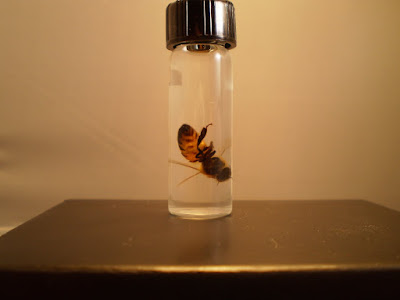
HS 028
Titanic Coal
Era: 1912/1994
Category: Rock
Wow, it's been awhile since the last post but I have not forgotten you all so I present the first post of 2011 and it happens to be one of my favorite artifacts of the Sholesonian. I'm sure everyone is familiar with the story, the RMS Titanic sets sail from Southampton, England en-route to New York City. The largest passenger steamship of its time it was known as The Unsinkable and a feat of the engineering at the time. The marvel ship set sail on the 10th of April, 1912 but as fate would have it the Titanic struck an iceberg and sunk to the deep and icy depths of the North Atlantic taking with it over 1,500 poor souls that fateful day five days later.
This little piece of black rock just happens to be an authentic piece of this tragic tale raised up 2.5 miles up from the ocean floor. In fact this particular piece is Object Number 94/0036, now I'm not too familiar with numbering system of the RMS Titanic, Inc. but my guess is that this object number belongs to the larger chunk of coal. You see, something I learned when I got this piece back in 2009 is that the pieces of coal on the Titanic were huge - much larger than the little bricks that you would see on old trains. These things were larger than watermelons and remember that coal is still a rock (On this note I wasn't able to determine whether this was bituminous (sedimentary rock) or anthracite (metamorphic rock) coal).
The Certificate of Authenticity states that this piece of coal was recovered from the wreck of White Star's pride the RMS Titanic during the 1994 Titanic Research and Recovery Expedition. It also includes the following little tidbit:
"Of the nearly nine hundred crew members who kept Titanic functioning, none worked harder than those assigned to the Ship's boilers. Deep in the recesses of the Ship, twenty-nine boilers, measuring over fifteen feet in diameter, produced the high-pressure steam needed to propel Titanic's engines and machinery. The fuel for these boilers was coal - and each day over six hundred and fifty tons of that coal had to be moved from the bunkers by the trimmers and shoveled by hand into the furnaces by the firemen. These men, known collectively as the 'black gang' for their coal-dust covered bodies, were the true engine that drove Titanic from Southampton towards New York."
It turns out that these small pieces of coal are the only authentic artifacts that are able to be sold from the wreck. Unfortunately, however the rest of the artifacts and the ship itself are slowly deteriorating in the hostile environment at the bottom of the sea. Despite the hard pressure, cold temperatures, and constantly being surrounded by water the largest threat are small bacteria that eat the rusting metal. When you view photographs of the wreck you see an abundance of oddly shaped stalactite like formations. These 'rusticles' as they are known, are formed from the bacteria eating, and eventually the whole ship will collapse in upon itself. A sad fate for a site with so much history.
Now we all know that the Titanic hit an iceberg, started to sink, and eventually split into two parts. What you may not know is that the Titanic actually received a warning of ice and changed its course miles South to hopefully avoid any large icebergs that were making their way down from Greenland. And as it turns out the moon was not out that night and the sea was calm making it harder to spot icebergs by observing the wave activity at their bases. There are also theories that the iceberg not only hit the side of the ship but grazed the bottom of it as well and researchers are still trying to determine whether this holds any water (no pun intended).
Sorry that I've rambled on with this, and congrats if you made it this far you're helping keep history alive, but this particular piece has so much more history tied with it and personal stories of tragedy and thankfulness. The double-bottom, considered to be infallible, proved no match for the wrath of nature. Mistakes were made, not only were there not enough seats available on the lifeboats but they weren't filled to capacity. The icy waters, were terribly cold and hypothermia wouldn't take long to set in for those who met their end in the freezing sea. There is a lot to learn from this terrible disaster, but unfortunately the last surviving passenger of the Titanic passed away a few years back so it is up to others to keep the history alive.
Despite such a long post there is still plenty to learn about the Titanic. Things like 'Did you know that many paper currencies have been retrieved from the wreckage?' So check out the
RMS Titanic, Inc website and the
Titanic Wikipedia page and turn on the Discovery or History channel sometime.









